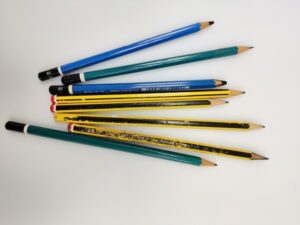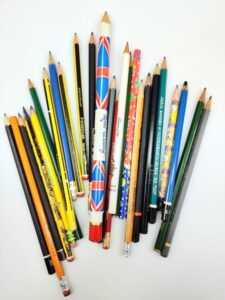So, the graphite discovered near Keswick was, and still is, the only large-scale deposit ever found in this solid form. This deposit was extremely pure and also solid, which meant it was easy to cut up into sticks but still soft enough that in order to use it for writing or drawing it needed to be encased. To begin with the graphite was wrapped in string or sheepskins. England enjoyed the monopoly in producing pencils until the 1600s, when the Germans developed a method of reconstituting graphite powder to form pencils.

In the 1560s, an Italian couple, Simonio and Lyndiana Bernacotti, made a wooden encasement for carpentry pencils. Their version was flat, just like carpentry pencils of today, with an oval centre and made from hollowed-out juniper wood. However, a new technique whereby two halves of a wooden cylinder were carved out, encased the graphite stick and then glued together is fundamentally the same method used in making pencils today.
Wars with France and the American revolution played their part in reducing the availability of pencils from England, which gave rise to Americans developing their own techniques. I am not going to go into all that, but the favourite wood used for pencils in the USA was eastern red cedar (Juniperus virginiana), which was chosen because it didn’t splinter and was aromatic. However, in the early 20th century, pencil manufacturers realised that the stock of cedar trees was being affected so they looked elsewhere for an alternative.
That alternative was the incense-cedar (sometimes written without the hyphen), a conifer which is part of the cypress family, which is still used today, as these trees are grown in managed forests. Incense-cedar also has technical properties which make it ideal for use in pencils. Its unique physical characteristics allow for close-tolerance, precision machining that provide a very smooth surface and exceptional ‘sharpenability’ in finished pencils.
Incense-cedar also stands up to wider variations in temperature and humidity without warping, cracking or shrinking (which is important for pencil factories in many regions where there are varying climates and for shipping pencils around the world). Finally, the smooth surface and relative lack of resin canals and pitch pockets assure that cedar pencils can be easily painted or stained with lacquer or water-based stains to a fine, smooth finish.
Graphite pencils, the most common type, tend to have the smoothest strokes when used. However, you can also get solid sticks of graphite which do not have a casing. Often called ‘woodless’ pencils, these are used by artists and allow for a larger coverage when used. Both wood encased and woodless pencils come in a range of hardness.
There is also a graphite pencil which, when mixed with water, writes with the smoothness of a pen but dries as graphite. You can buy liquid graphite and apply it with a brush; it comes as permanent or as a re-wettable solution in tubes or pots. If you are into graphic drawing, there are plenty of videos online showing how best to use it.
Carbon pencils are much smoother than graphite and are not as easy to smudge so have minimal dust, but they do blend well. Generally, they are made from clay and lamp black, a black pigment traditionally produced by charring organic materials such as wood or bone but also made from the soot produced in oil lamps.
Charcoal pencils come in all sizes and hardness. They too come encased or not and are fabulous for creating smudged artworks. You can even make your own charcoal by wrapping twigs in many layers of aluminium and placing them at the bottom of a bonfire. Wait until the heat has gone out of the fire and remove them. Different woods give different effects and colours, which are great for art experimentation. It is also great fun.

Coloured pencils, including watercolour pencils, is possibly a subject for a separate blog, but basically, they were only developed in the 20th century and are made from high concentrations of colour pigment mixed with wax or oil and binding agents.
We are all used to the H or HB markings on our pencils, with H denoting its hardness but there is no international standard. This means that different companies produce pencils with the same marking but not necessarily the same hardness.
In Europe, most pencil manufacturers use the same grading system. H refers to the hardness of the graphite; B refers to the blackness produced by the pencil and F is used to describe fineness, but they are not necessarily particularly fine! I know; it’s confusing.
The graph below should give you a rough idea of what each pencil is designed for. Different manufacturers make different ranges and numbers of different pencils within that range. Basically, you have to figure out which pencils you personally prefer to use and then probably stick with them if you are looking for consistency.
| Pencil grading and hardness | |||
| nature | example of uses | ||
| 9B | extremely soft and dark | used by artists for | |
| 8B | sketching | ||
| 7B | art studies | ||
| 6B | drafting | ||
| 5B | |||
| 4B | |||
| 3B | soft | freehand drawing | |
| 2B | writing | ||
| B | |||
| HB | medium | writing | |
| F | linear drawing | ||
| H | hard | technical drawing | |
| 2H | mathematical drawing | ||
| 3H | very hard | technical detailed plans | |
| 4H | graphical representations | ||
| 5H | |||
| 6H | extremely hard, | for special purposes: | |
| 7H | light grey | lithography – stone printmaking | |
| 8H | cartography – map making | ||
| 9H | xylography- graving on wood | ||
An estimated 2/3 of all pencils in the USA are painted yellow. There are a few possible reasons for this: dipping pencils in 14 carat gold to denote the very best quality; a reference to the Austro-Hungarian flag after the location of one brand; and, possibly, an association with the Orient at a time when Siberian graphite was considered to be the best quality. Other pencil manufactures copied the colour to imply that their products were also of this superior quality.
Pencils are traditionally round, possibly because the hollowing out of twigs gives a rounded outer. However, they can also have a hexagonal casing or maybe a triangular outer to stop them from rolling off a surface. Typically, carpenters’ pencils are rectangular or flat, again so that they don’t easily roll away or fall off a building when you are working. They tend to stay put.
If you have enjoyed reading this post, please like and follow me and please share it with people who you think might be interested. I am always on the lookout for new artists to feature as I know how much everyone enjoys reading about other artists. Also, if you think there is a subject you would like to know more about and would like me to write about, I will be happy to consider it. Sharing, liking and following my blogs increases the number of people the algorithm shows the blogs to, so please share. Thank you in advance for supporting me this way.
